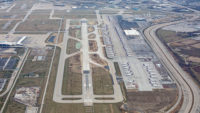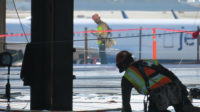Sacramento International Airport Runway 16R-34L Pavement Rehabilitation | Submitted by Granite Construction Co.
Sacramento, Calif.
Region: ENR California
Owner: Sacramento County Construction Management and Inspection Division
Lead Design Firm: AECOM
General Contractor: Granite Construction Co.
Subcontractors: Centerline Striping Co.; Curry Group Inc.; Lean Engineering; MVE Inc.; Q&D Construction; Studebaker Brown Electric Inc.; Twining Group Inc.
The team tasked with completely rehabilitating an 8,500-ft-long, 150-ft-wide runway at Sacramento International Airport in just 6½ months not only did so on schedule, but also achieved a record industry standard for pavement smoothness.
The project entailed demolition and reconstruction of the existing runway and construction of a subsurface drainage system. The runway, just one of two, has an instrument landing system that allows pilots to land in foggy conditions. Crews worked up to seven 12-hour days a week and achieved 105,400 worker hours with zero injuries.
Unexpected site conditions included existing electrical conduits comprising asbestos cement, areas of unsuitable subgrade and the need to fully rebuild rather than repave existing blast pads. The team worked to quickly address the $4 million in scope change and keep the job on schedule.
Granite Construction used 3D paving controls to produce an industry gold standard in smoothness. “This was the first time Granite Construction has utilized 3D stringless concrete paving technology,” says Steve Lynch, regional project manager with Granite. “We have utilized robotic total stations for 3D grade controls on our grading and asphalt paving equipment on multiple prior projects.”
The tools helped to produce finish grades with a maximum deviation of 0.02 ft from design grades and an average smoothness profile index rating of 1.7 in./mile, compared to the allowable 7 in./mile.
The saw-cut grooving operation generated 750,000 gallons of concrete slurry water that requires proper disposal. The project team developed and implemented a solution using an industrial slurry press that allowed for continual reuse of the water by pressing out the solids. All solids were then recycled into aggregate base and no slurry water was discharged. The project team also reused 100% of 115,000 cu yd of demolished and excavated materials.








Post a comment to this article
Report Abusive Comment